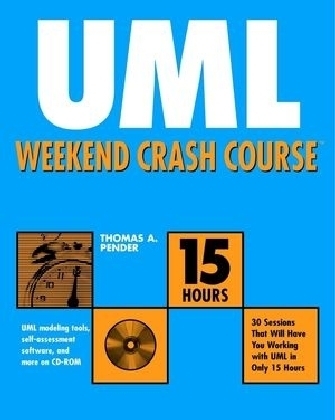
UML Weekend Crash Course
John Wiley & Sons Inc
978-0-7645-4910-6 (ISBN)
- Titel ist leider vergriffen;
keine Neuauflage - Artikel merken
ABOUT THE TECHNOLOGY
What it is: UML (Unified Modeling Language) is a graphical modeling language used to specify, visualize, construct, and document applications and software systems, which are implemented with components and object-oriented programming languages, such as Java, C++, and Visual Basic. UML incorporates the object-oriented community's consensus on core modeling concepts and provides a standard way for developers to communicate the details of system design and development. In addition to object-oriented modeling of applications, UML is also used for business-process modeling, data modeling, and XML modeling.
Purpose of modeling: Models for software systems are as important as having a blueprint for a large building, or an outline for a book. Good models enhance communication among project teams and assure architectural soundness. The more complex the software system, the more important it is to have models that accurately describe the system and can be understood by everyone. UML helps provide this via a standard for graphical diagrams. Just like an architect can understand the notations on any blueprint, UML enables software engineers and business managers to understand the design of any software system, even if the original designers have long left the company.
Organization behind it: Object Management Group (OMG) (www.omg.org). (UML Resource Page at OMG Web site is www.omg.org/uml.) The OMG produces and maintains the UML standard, an internationally recognized standard. The OMG is an open membership, not-for-profit consortium that produces and maintains computer industry specifications for interoperable enterprise applications. Its membership roster (about 800) includes just about every large company in the computer industry and hundreds of smaller ones. Most of the companies that shape enterprise and Internet computing are represented on the OMG's Board of Directors.
Companies that contributed to the UML Standard: Realizing that UML would be strategic to their business, the following companies contributed their ideas to the first UML standard: Digital Equipment Corp, HP, i-Logix, IntelliCorp, IBM, ICON Computing, MCI, Microsoft, Oracle, Rational Rose, TI, and Unisys.
Companies that use UML: It is safe to say that all Fortune 1000 companies are currently using UML, or are moving toward UML to model and design their applications and systems. This includes companies from all vertical industries, from Coca Cola to Warner Brothers, from CVS Pharmacy to Lockhead Martin Aerospace. You name the company - if they have an IT department, they are using UML.
Thomas A. Pender (Reno, NV) is the author of six courses on UML. He has taught throughout the United States and in 12 other countries and has over 20 years of systems development experience in various industries. Tom has spent the past four years providing teaching and consulting services to companies that are transitioning to object-oriented technologies.
Preface.
FRIDAY.
Part I-Friday Evening.
Session 1-What Is the UML?
Session 2-UML and Development Methodologies.
Session 3-How to Approach the UML.
Session 4-Defining Requirements for the Case Study.
SATURDAY.
Part II-Saturday Morning.
Session 5-Understanding the Use Case Model.
Session 6-Building the Use Case Diagram.
Session 7-Building the Use Case Narrative.
Session 8-Identifying the Use Case Scenarios.
Session 9-Modeling the Static View: The Class Diagram.
Session 10-The Class Diagram: Associations.
Part III-Saturday Afternoon.
Session 11-The Class Diagram: Aggregation and Generalization.
Session 12-Applying the Class Diagram to the Case Study.
Session 13-Modeling the Static View: The Object Diagram.
Session 14-Modeling the Functional View: The Activity Diagram.
Session 15-Applying the Activity Diagram to the Case Study.
Session 16-Modeling the Dynamic View: The Sequence Diagram.
Part IV-Saturday Evening.
Session 17-Applying the Sequence Diagram to the Case Study.
Session 18-Modeling the Dynamic View: The Collaboration Diagram.
Session 19-Applying the Collaboration Diagram to the Case Study.
Session 20-Modeling the Dynamic View: The Statechart Diagram.
SUNDAY.
Part V-Sunday Morning.
Session 21-Applying the Basic Statechart to the Case Study.
Session 22-Modeling the Extended Features of the Statechart.
Session 23-Applying the Extended Statechart Features to the Case Study.
Session 24-Modeling the Development Environment.
Session 25-Modeling the Static View: The Component Diagram.
Session 26-Modeling the Static View: The Deployment Diagram.
Part VI-Sunday Afternoon.
Session 27-Introduction to Web Development with Java.
Session 28-Analysis and Architectural Design of a Web Application.
Session 29-Design of a Web Application.
Session 30-UML Modeling Tools.
Appendix A: Answers to Part Reviews.
Appendix B: What's on the CD-ROM?
Glossary.
Index.
End-User License Agreement.
| Erscheint lt. Verlag | 15.7.2002 |
|---|---|
| Reihe/Serie | Weekend Crash Course |
| Verlagsort | New York |
| Sprache | englisch |
| Maße | 188 x 234 mm |
| Gewicht | 558 g |
| Themenwelt | Mathematik / Informatik ► Informatik ► Programmiersprachen / -werkzeuge |
| Informatik ► Software Entwicklung ► Objektorientierung | |
| ISBN-10 | 0-7645-4910-3 / 0764549103 |
| ISBN-13 | 978-0-7645-4910-6 / 9780764549106 |
| Zustand | Neuware |
| Haben Sie eine Frage zum Produkt? |